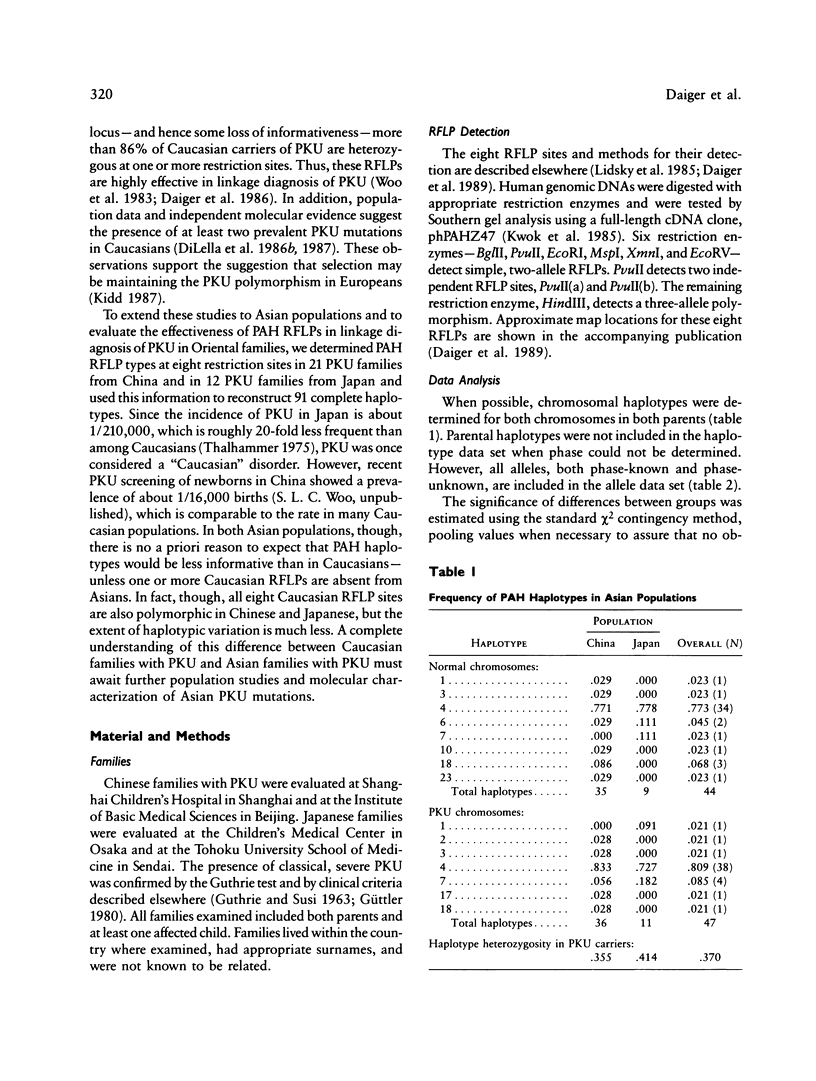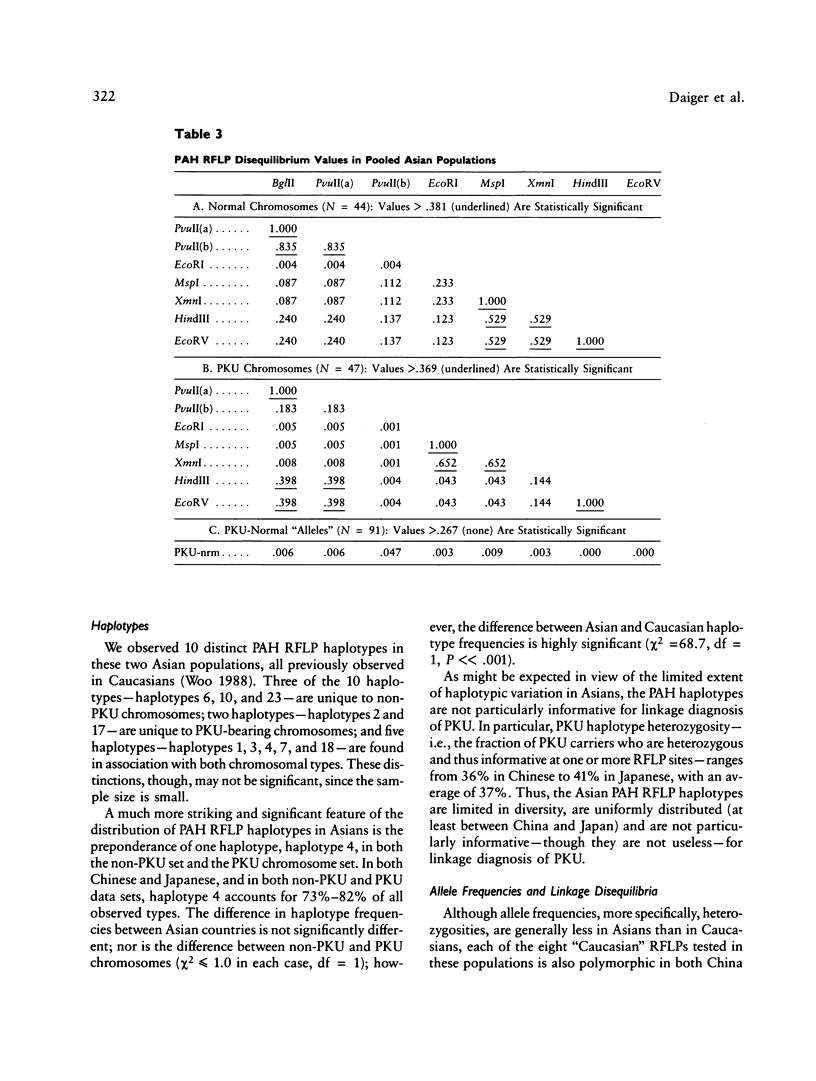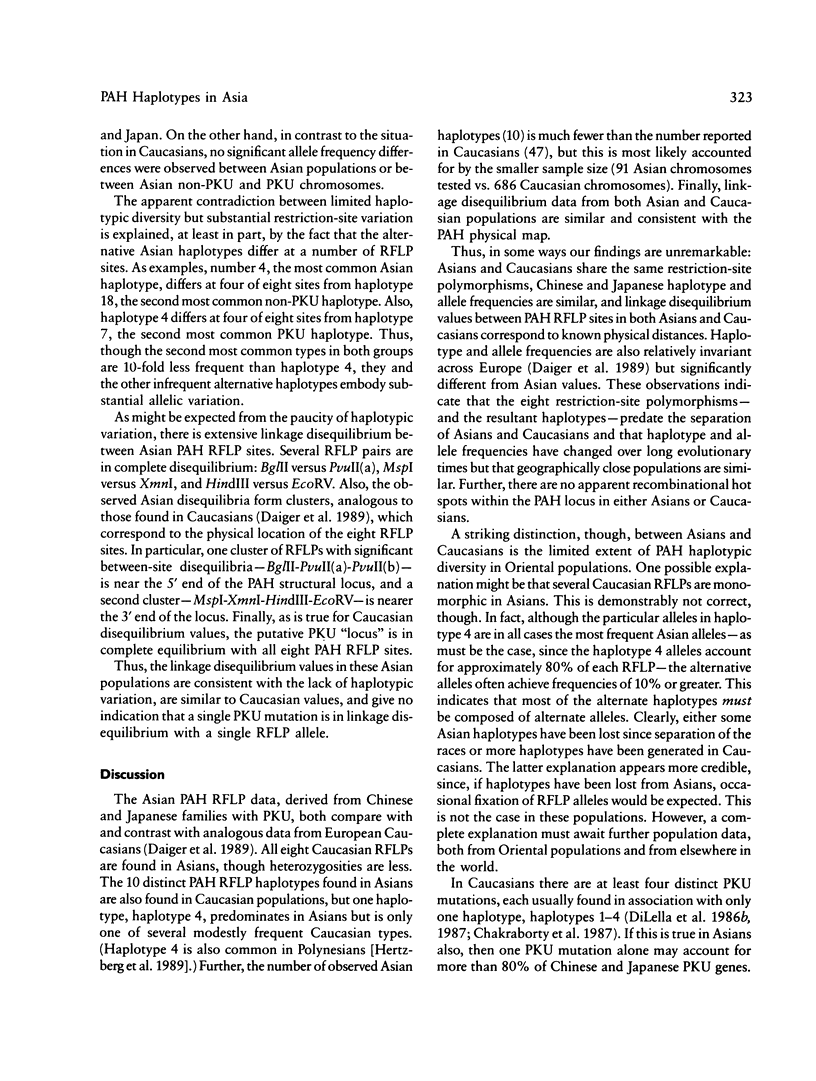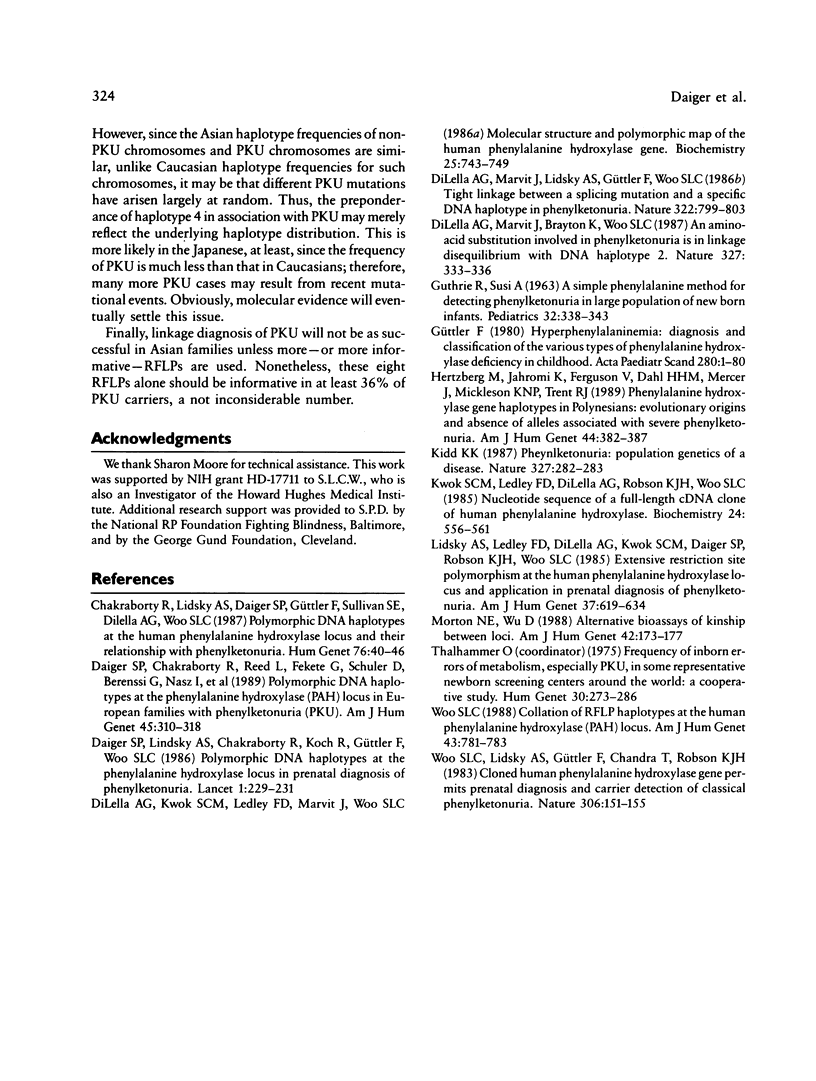Abstract
DNA polymorphisms at the phenylalanine hydroxylase (PAH) locus have proved highly efiective in linkage diagnosis of phenylketonuria (PKU) in Caucasian families. More than 10 RFLP sites have been reported within the PAH structural locus in Caucasians. With information from affected and unaffected offspring in PKU families it is often possible to reconstruct complete RFLP haplotypes in parents and to use these haplotypes to follow the segregation of PKU within families and to determine the distribution of PKU chromosomes within populations. To establish the utility of these RFLPs in charaterizing Asian families with PKU, we typed eight DNA sites in 21 Chinese families and 12 Japanese families with classical PKU. The eight RFLPs were chosen for their informativeness in Caucasians. From these families we reconstructed a total of 91 complete PAH haplotypes, 44 from non-PKU chromosomes and 47 from PKU-bearing chromosomes. Although all eight marker sites are polymorphic in both Chinese and Japanese, there is much less haplotypic variation in Asians than in Caucasians. In particular, one haplotype alone, haplotype 4, accounts for more than 77% of non-PKU chromosomes and for more than 80% of PKU-bearing chromosomes. Haplotype 4 is also relatively common in Caucasians. The next most common Asian haplotype is 10 times less frequent than haplotype 4. By contrast, in many Caucasian populations the sum of the frequencies of the five most common haplotypes is still less than 80%, and several of the most common haplotypes are equally frequent. Even though the extent of haplotypic variation in Asians is severely limited, the few haplotypes that are found often differ at a number of RFLP sites. This accounts for the observation that haplotypes show little variation in Chinese and Japanese but that the individual RFLP sites are all polymorphic in both populations. It appears that these RFLPs predate the separation of Asians and Caucasians but that the haplotypic variation has either decreased or increased in one or the other racial group since then. Although the PAH RFLPs and haplotypes will not be as useful in Asian families with PKU as in Caucasian families with PKU, at least 36% of Asian carriers of PKU are heterozygous–and hence informative–at one or more RFLP sites.
Full text
PDF





Selected References
These references are in PubMed. This may not be the complete list of references from this article.
- Chakraborty R., Lidsky A. S., Daiger S. P., Güttler F., Sullivan S., Dilella A. G., Woo S. L. Polymorphic DNA haplotypes at the human phenylalanine hydroxylase locus and their relationship with phenylketonuria. Hum Genet. 1987 May;76(1):40–46. doi: 10.1007/BF00283048. [DOI] [PubMed] [Google Scholar]
- Daiger S. P., Chakraborty R., Reed L., Fekete G., Schuler D., Berenssi G., Nasz I., Brdicka R., Kamarýt J., Pijácková A. Polymorphic DNA haplotypes at the phenylalanine hydroxylase (PAH) locus in European families with phenylketonuria (PKU). Am J Hum Genet. 1989 Aug;45(2):310–318. [PMC free article] [PubMed] [Google Scholar]
- Daiger S. P., Lidsky A. S., Chakraborty R., Koch R., Güttler F., Woo S. L. Polymorphic DNA haplotypes at the phenylalanine hydroxylase locus in prenatal diagnosis of phenylketonuria. Lancet. 1986 Feb 1;1(8475):229–232. doi: 10.1016/s0140-6736(86)90771-3. [DOI] [PubMed] [Google Scholar]
- DiLella A. G., Kwok S. C., Ledley F. D., Marvit J., Woo S. L. Molecular structure and polymorphic map of the human phenylalanine hydroxylase gene. Biochemistry. 1986 Feb 25;25(4):743–749. doi: 10.1021/bi00352a001. [DOI] [PubMed] [Google Scholar]
- DiLella A. G., Marvit J., Brayton K., Woo S. L. An amino-acid substitution involved in phenylketonuria is in linkage disequilibrium with DNA haplotype 2. 1987 May 28-Jun 3Nature. 327(6120):333–336. doi: 10.1038/327333a0. [DOI] [PubMed] [Google Scholar]
- DiLella A. G., Marvit J., Lidsky A. S., Güttler F., Woo S. L. Tight linkage between a splicing mutation and a specific DNA haplotype in phenylketonuria. 1986 Aug 28-Sep 3Nature. 322(6082):799–803. doi: 10.1038/322799a0. [DOI] [PubMed] [Google Scholar]
- GUTHRIE R., SUSI A. A SIMPLE PHENYLALANINE METHOD FOR DETECTING PHENYLKETONURIA IN LARGE POPULATIONS OF NEWBORN INFANTS. Pediatrics. 1963 Sep;32:338–343. [PubMed] [Google Scholar]
- Güttler F. Hyperphenylalaninemia: diagnosis and classification of the various types of phenylalanine hydroxylase deficiency in childhood. Acta Paediatr Scand Suppl. 1980;280:1–80. [PubMed] [Google Scholar]
- Hertzberg M., Jahromi K., Ferguson V., Dahl H. H., Mercer J., Mickleson K. N., Trent R. J. Phenylalanine hydroxylase gene haplotypes in Polynesians: evolutionary origins and absence of alleles associated with severe phenylketonuria. Am J Hum Genet. 1989 Mar;44(3):382–387. [PMC free article] [PubMed] [Google Scholar]
- Kidd K. K. Phenylketonuria. Population genetics of a disease. 1987 May 28-Jun 3Nature. 327(6120):282–283. doi: 10.1038/327282a0. [DOI] [PubMed] [Google Scholar]
- Kwok S. C., Ledley F. D., DiLella A. G., Robson K. J., Woo S. L. Nucleotide sequence of a full-length complementary DNA clone and amino acid sequence of human phenylalanine hydroxylase. Biochemistry. 1985 Jan 29;24(3):556–561. doi: 10.1021/bi00324a002. [DOI] [PubMed] [Google Scholar]
- Lidsky A. S., Ledley F. D., DiLella A. G., Kwok S. C., Daiger S. P., Robson K. J., Woo S. L. Extensive restriction site polymorphism at the human phenylalanine hydroxylase locus and application in prenatal diagnosis of phenylketonuria. Am J Hum Genet. 1985 Jul;37(4):619–634. [PMC free article] [PubMed] [Google Scholar]
- Morton N. E., Wu D. Alternative bioassays of kinship between loci. Am J Hum Genet. 1988 Jan;42(1):173–177. [PMC free article] [PubMed] [Google Scholar]
- Woo S. L. Collation of RFLP haplotypes at the human phenylalanine hydroxylase (PAH) locus. Am J Hum Genet. 1988 Nov;43(5):781–783. [PMC free article] [PubMed] [Google Scholar]
- Woo S. L., Lidsky A. S., Güttler F., Chandra T., Robson K. J. Cloned human phenylalanine hydroxylase gene allows prenatal diagnosis and carrier detection of classical phenylketonuria. Nature. 1983 Nov 10;306(5939):151–155. doi: 10.1038/306151a0. [DOI] [PubMed] [Google Scholar]


